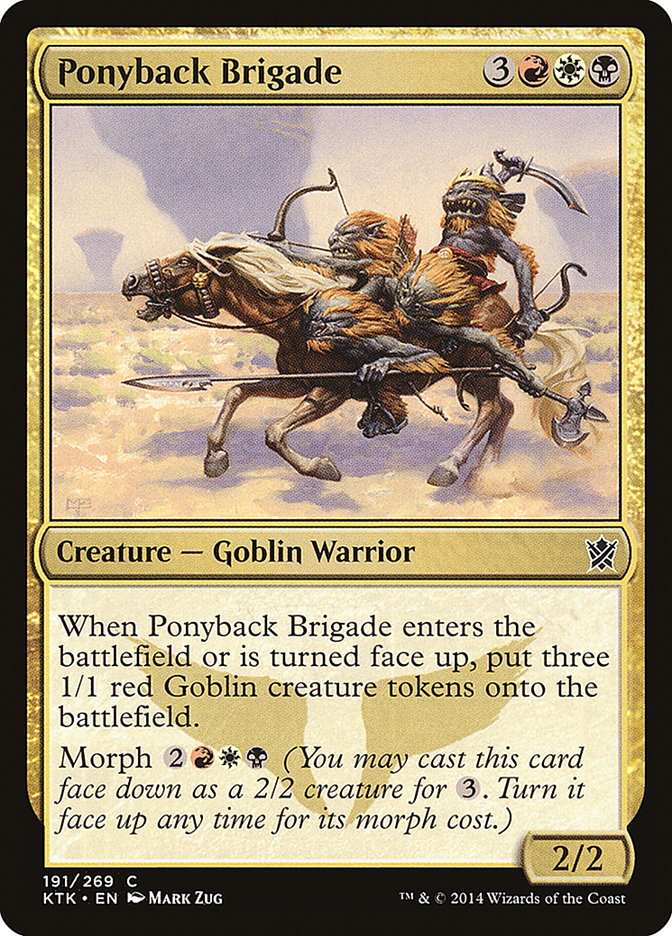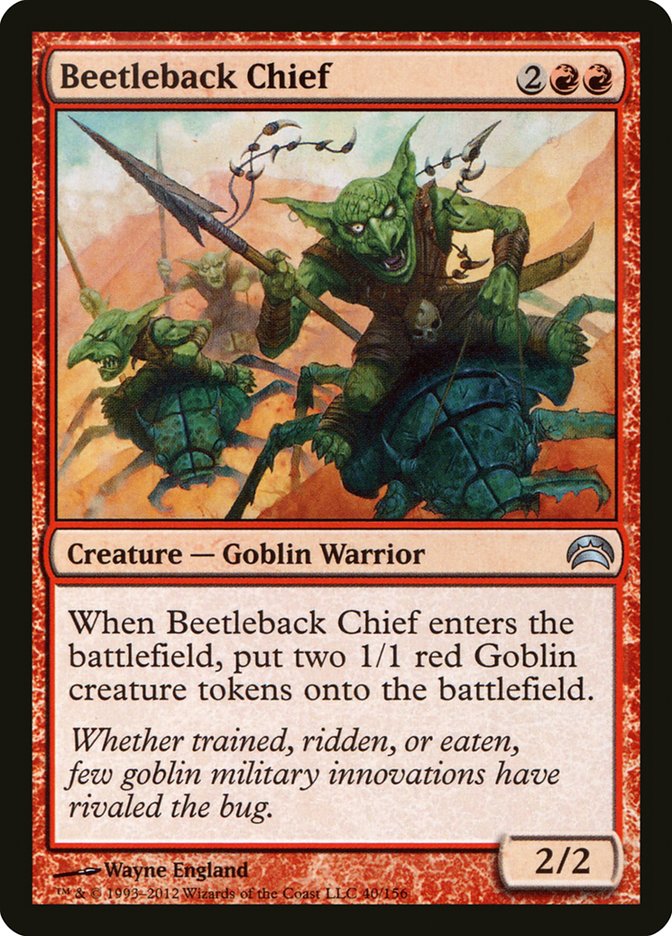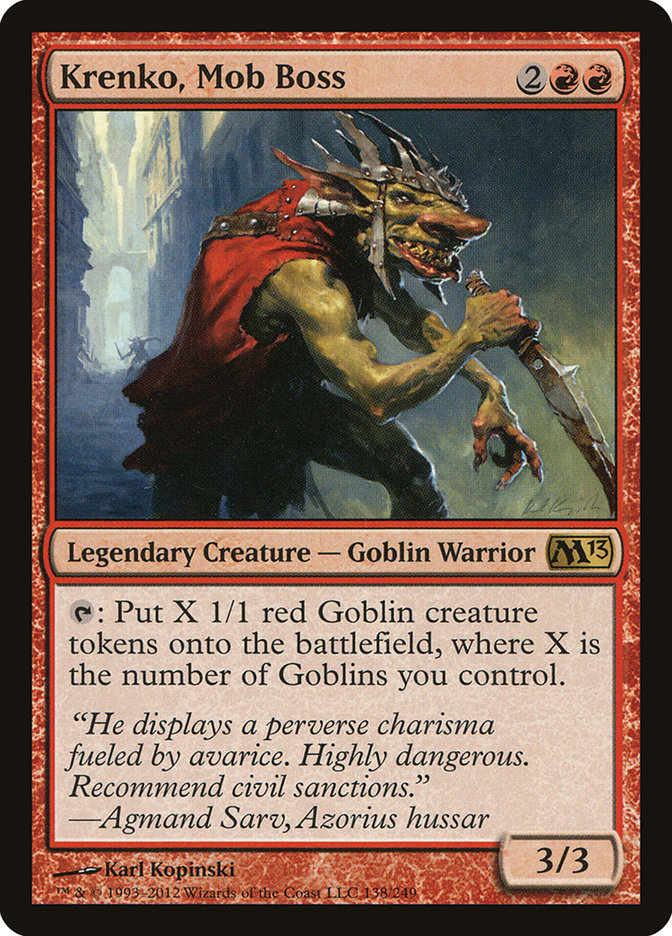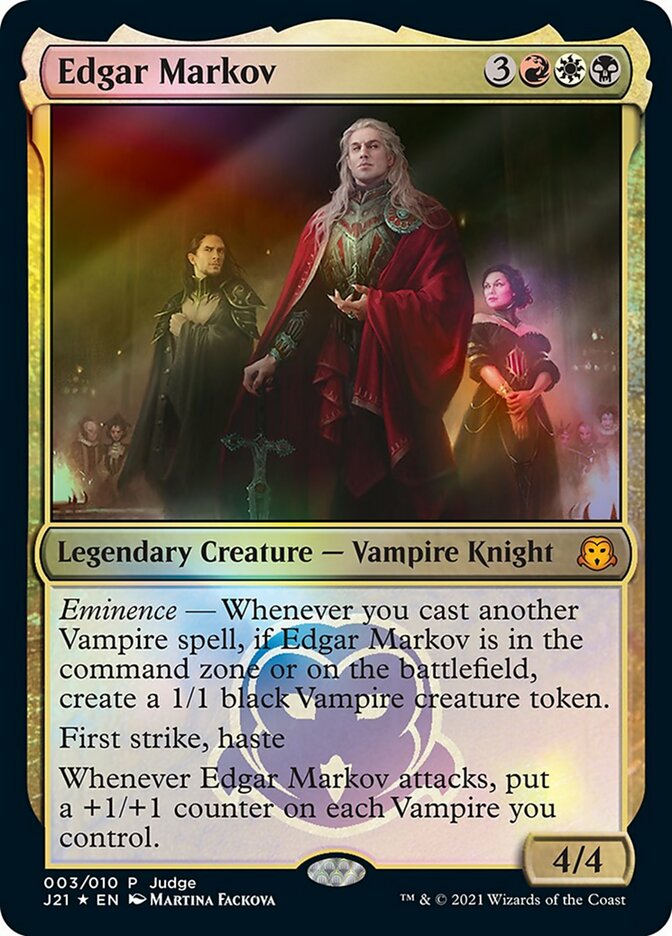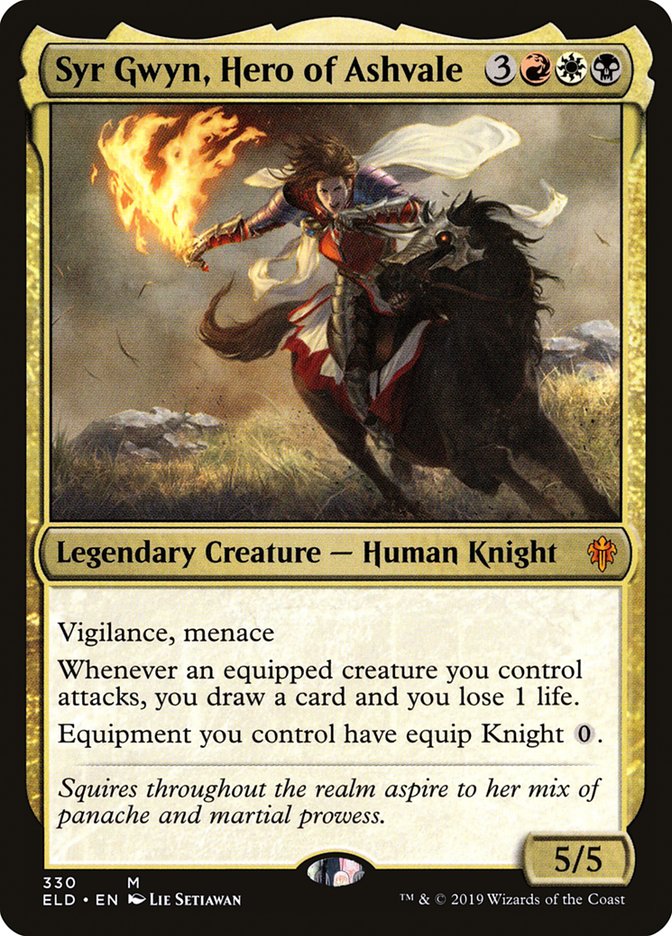Ponyback Brigade MTG Card
| Mana cost | |
| Converted mana cost | 6 |
| Rarity | Common |
| Type | Creature — Goblin Warrior |
| Abilities | Morph |
| Released | 2014-09-26 |
| Set symbol | |
| Set name | Khans of Tarkir |
| Set code | KTK |
| Power | 2 |
| Toughness | 2 |
| Number | 191 |
| Frame | 2015 |
| Layout | Normal |
| Border | Black |
| Illustred by | Mark Zug |
Text of card
When Ponyback Brigade enters the battlefield or is turned face up, put three 1/1 red Goblin creature tokens onto the battlefield. Morph (You may cast this card face down as a 2/2 creature for . Turn it face up any time for its morph cost.)
Cards like Ponyback Brigade
Ponyback Brigade is an intriguing creature card that invites comparisons with other token-generating cards in Magic: The Gathering. Similar to Seige-Gang Commander, Ponyback Brigade provides a strong board presence by creating multiple creature tokens upon entering the battlefield. While Seige-Gang Commander brings forth three Goblin tokens, Ponyback Brigade also generates three Goblins but adds the utility of morphing, allowing for tactical surprise.
Another card that echoes Ponyback Brigade’s token strategy is Beetleback Chief. This card also creates two Goblin tokens when it comes into play, albeit less than Ponyback Brigade. However, Beetleback Chief requires less mana investment, making it a quicker but less expansive alternative for swarming the board. Krenko, Mob Boss stands as a notable contrast. Although it doesn’t create tokens on entry, over time, it can potentially produce an overwhelming number of Goblins, outclassing the one-time effect of both previous cards.
In summary, while many cards share the feature of producing Goblin tokens in Magic: The Gathering, Ponyback Brigade holds its own with its morph ability and sizable one-time production of tokens. It provides a valuable burst in numbers for any deck focusing on Goblin synergy or token strategies.
Cards similar to Ponyback Brigade by color, type and mana cost
Card Pros
Card Advantage: When it comes to building a substantial lead in the game, Ponyback Brigade can be a real game-changer. Upon entering the battlefield, this card immediately creates three 1/1 red Goblin creature tokens. This trio of tokens represents valuable card advantage as you effectively have multiple creatures at your command with a single card played, allowing you to outnumber and overwhelm your opponents.
Resource Acceleration: Ponyback Brigade brings more than just creatures to the battlefield; the tokens it generates can be used as resources for various purposes. Whether you’re looking to enhance your board presence or have sacrificial pieces for other card abilities, this card helps accelerate your game plan by increasing your resources significantly, giving you more flexibility and potential for strategic plays.
Instant Speed: While Ponyback Brigade is not an instant itself, its morph ability offers a strategic advantage similar to playing cards at instant speed. Of key importance is the option to turn it face up at any time you could cast an instant, surprising your opponent with a swift force multiplication during their turn or at the end of it, thus altering the board state significantly in your favor at critical moments.
Card Cons
Discard Requirement: While Ponyback Brigade offers versatility in play, some players might find the requirement of discarding another card to unleash its potential a bit restrictive, especially when the hand is already dwindling.
Specific Mana Cost: This card demands a tri-color mana investment, which can pose deck-building constraints. With its Mardu allegiance, not all decks can accommodate the specific color combination of red, white, and black mana without impacting the mana curve.
Comparatively High Mana Cost: With a casting cost of six mana, Ponyback Brigade might arrive too late in the game, particularly when faster, low-cost creatures are defining the battlefield. In formats where tempo plays a critical role, its cost could be a definitive con.
Reasons to Include Ponyback Brigade in Your Collection
Versatility: Ponyback Brigade is a flexible card that can slide into various deck archetypes. With its morph ability, it can be played early as a surprise blocker or later for a sudden influx of Goblin tokens, adapting to different pace and play styles effectively.
Combo Potential: When flipped, it brings three Goblin tokens into play, offering immediate synergy with cards and strategies that capitalize on wide board states or token generation, such as impact tremors or boost effects from lords.
Meta-Relevance: Versatile in both aggressive and mid-range decks, Ponyback Brigade holds its ground in a changing meta. It interacts well with sacrifice outlets and overrun strategies that are ever-present in various formats, affirming its adaptability and enduring relevance.
How to Beat
Ponyback Brigade is a multifaceted creature that can pose a challenge when you’re facing it across the battlefield in Magic: The Gathering. With its morph ability and the potential to create three 1/1 red Goblin creature tokens when turned face up, it can quickly change the tide of the game by bolstering your opponent’s army. To effectively combat this, board control is key. Cards that can deal damage to multiple creatures at once, such as “Pyroclasm” or “Whipflare,” can clear out those pesky Goblin tokens before they can be utilized for attacks or other synergistic strategies.
Another approach is to prevent the Ponyback Brigade from flipping face up in the first place. Counter spells like “Essence Scatter” can intercept the creature when it’s initially cast. Alternatively, if it’s already on the field, you can use removal spells like “Murder” to take it out before the opponent has a chance to use its morph ability. By managing your resources wisely and keeping an eye on your opponent’s mana, you can anticipate when they’re likely to flip Ponyback Brigade and strategize accordingly to maintain control of the game.
Ultimately, understanding when to apply pressure and when to hold back for countermagic or removal plays are crucial in overcoming the potential swarm that Ponyback Brigade can unleash on the battlefield.
Where to buy
If you're looking to purchase Ponyback Brigade MTG card by a specific set like Khans of Tarkir, there are several reliable options to consider. One of the primary sources is your local game store, where you can often find booster packs, individual cards, and preconstructed decks from current and some past sets. They often offer the added benefit of a community where you can trade with other players.
For a broader inventory, particularly of older sets, online marketplaces like TCGPlayer, Card Kingdom and Card Market offer extensive selections and allow you to search for cards from specific sets. Larger e-commerce platforms like eBay and Amazon also have listings from various sellers, which can be a good place to look for sealed product and rare finds.
Additionally, Magic’s official site often has a store locator and retailer lists for finding Wizards of the Coast licensed products. Remember to check for authenticity and the condition of the cards when purchasing, especially from individual sellers on larger marketplaces.
Below is a list of some store websites where you can buy the Ponyback Brigade and other MTG cards:
 BUY NOW
BUY NOW BurnMana is an official partner of TCGPlayer
- eBay
- Card Kingdom
- Card Market
- Star City Games
- CoolStuffInc
- MTG Mint Card
- Hareruya
- Troll and Toad
- ABU Games
- Card Hoarder Magic Online
- MTGO Traders Magic Online
See MTG Products
Legalities
Magic the Gathering formats where Ponyback Brigade has restrictions
| Format | Legality |
|---|---|
| Historicbrawl | Legal |
| Historic | Legal |
| Legacy | Legal |
| Paupercommander | Legal |
| Oathbreaker | Legal |
| Gladiator | Legal |
| Pioneer | Legal |
| Commander | Legal |
| Modern | Legal |
| Pauper | Legal |
| Vintage | Legal |
| Duel | Legal |
| Explorer | Legal |
| Penny | Legal |
| Timeless | Legal |
Rules and information
The reference guide for Magic: The Gathering Ponyback Brigade card rulings provides official rulings, any errata issued, as well as a record of all the functional modifications that have occurred.
| Date | Text |
|---|---|
| 2014-09-20 | A permanent that turns face up or face down changes characteristics but is otherwise the same permanent. Spells and abilities that were targeting that permanent, as well as Auras and Equipment that were attached to the permanent, aren’t affected. |
| 2014-09-20 | Any time you have priority, you may turn the face-down creature face up by revealing what its morph cost is and paying that cost. This is a special action. It doesn’t use the stack and can’t be responded to. Only a face-down permanent can be turned face up this way; a face-down spell cannot. |
| 2014-09-20 | At any time, you can look at a face-down spell or permanent you control. You can’t look at face-down spells or permanents you don’t control unless an effect instructs you to do so. |
| 2014-09-20 | Because the permanent is on the battlefield both before and after it’s turned face up, turning a permanent face up doesn’t cause any enters-the-battlefield abilities to trigger. |
| 2014-09-20 | If a face-down permanent leaves the battlefield, you must reveal it. You must also reveal all face-down spells and permanents you control if you leave the game or if the game ends. |
| 2014-09-20 | Morph lets you cast a card face down by paying , and lets you turn the face-down permanent face up any time you have priority by paying its morph cost. |
| 2014-09-20 | The face-down spell has no mana cost and has a converted mana cost of 0. When you cast a face-down spell, put it on the stack face down so no other player knows what it is, and pay . This is an alternative cost. |
| 2014-09-20 | When the spell resolves, it enters the battlefield as a 2/2 creature with no name, mana cost, creature types, or abilities. It’s colorless and has a converted mana cost of 0. Other effects that apply to the creature can still grant it any of these characteristics. |
| 2014-09-20 | You must ensure that your face-down spells and permanents can easily be differentiated from each other. You’re not allowed to mix up the cards that represent them on the battlefield in order to confuse other players. The order they entered the battlefield should remain clear. Common methods for doing this include using markers or dice, or simply placing them in order on the battlefield. |
